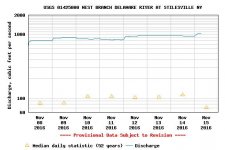New release from FUDR.......
Delaware River Drought Update
Last week the Delaware River Basin Commission (DRBC) declared a "Drought Watch" for the entire Delaware River watershed. This declaration enables the DRBC to uniformly manage basin reservoirs in a way that conserves water supply, adjusts river flows, and repels the northward migration of the "salt line" out of the Delaware Bay. As of November 20, the salt line was 21 miles from New Jersey and Pennsylvania water supply intakes and it has not been this far north since 1963. In the Upper Delaware region the combination of dry weather conditions and large required water releases to meet downstream flow targets at Montague and Trenton, NJ have caused alarmingly low levels in the NYC Delaware basin reservoirs (Cannonsville, Pepacton, Neversink). If dry conditions persist in the watershed, releases from the NYC reservoirs will still be required to meet these flow targets (further draining already low reservoirs). Even if enough precipitation occurs below the NYC reservoirs to satisfy the flow targets, depleted reservoir levels will trigger very low releases to the river. This could occur over an extended period of time, unless and until the coming months bring significant precipitation to replenish the reservoirs. We will be keeping a close eye on the impacts to the river under these challenging conditions and working closely with reservoir and river managers to ensure maximum protections are implemented.






